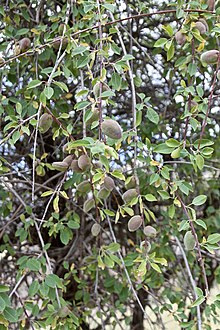Prunus bucharica is a species of wild almond native to Tajikistan, Uzbekistan and Afghanistan, preferring to grow at 1000-1800 m above sea level. Long thought to be one of the wild species that contributed to the origin of the cultivated almond (Prunus dulcis), genetic testing of both nuclear and chloroplast DNA has shown that to be untrue; the closest relative (and presumed lone ancestor) of Prunus dulcis is Prunus fenzliana.[3][4]
| Prunus bucharica | |
|---|---|

| |
| Scientific classification | |
| Kingdom: | Plantae |
| Clade: | Tracheophytes |
| Clade: | Angiosperms |
| Clade: | Eudicots |
| Clade: | Rosids |
| Order: | Rosales |
| Family: | Rosaceae |
| Genus: | Prunus |
| Species: | P. bucharica
|
| Binomial name | |
| Prunus bucharica | |
| Synonyms | |
Description
editPrunus bucharica is a tall shrub or small tree between 1.5 and 7 m tall. Prunus bucharica differs from all other almonds in having broadly ovate leaves and a completely smooth endocarp.[5]
References
edit- ^ Korsh. Bull. Acad. Petersb., ser. 5, 14: 92. 1901
- ^ Ann, Sci. Nat. ser. 6, 16: 281. 1883.
- ^ Zeinalabedini, M.; Khayam-Nekoui, M.; Grigorian, V.; Gradziel, T.M.; Martínez-Gómez, P. (26 July 2010). "The origin and dissemination of the cultivated almond as determined by nuclear and chloroplast SSR marker analysis". Scientia Horticulturae. 125 (4): 593–601. doi:10.1016/j.scienta.2010.05.007.
- ^ "Prunus bucharica (Bokhara almond)".
- ^ Yazbek, Mariana Mostafa (February 2010). Systematics of Prunus Subgenus Amygdalus: Monograph and Phylogeny (PDF) (PhD). Cornell University.